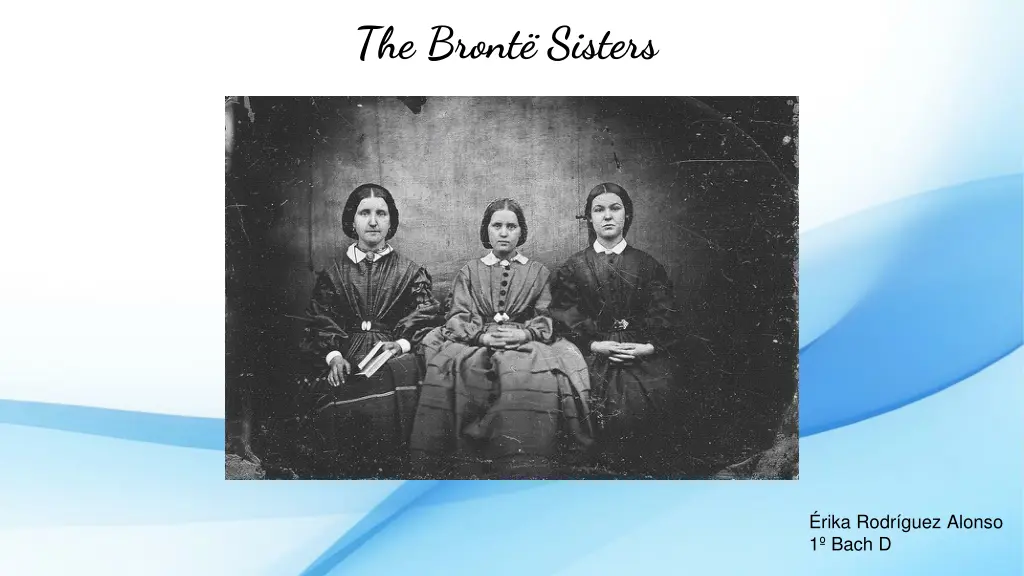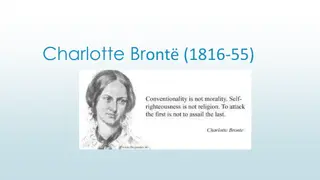
Brontë Sisters: Victorian Era Novelists
Discover the fascinating lives of the Brontë sisters - Emily, Charlotte, and Anne - renowned authors of Victorian-era novels. Follow their journey from childhood to literary success and tragedy, uncovering the inspirations behind their timeless works like "Jane Eyre" and "Wuthering Heights."
Download Presentation

Please find below an Image/Link to download the presentation.
The content on the website is provided AS IS for your information and personal use only. It may not be sold, licensed, or shared on other websites without obtaining consent from the author. If you encounter any issues during the download, it is possible that the publisher has removed the file from their server.
You are allowed to download the files provided on this website for personal or commercial use, subject to the condition that they are used lawfully. All files are the property of their respective owners.
The content on the website is provided AS IS for your information and personal use only. It may not be sold, licensed, or shared on other websites without obtaining consent from the author.
E N D
Presentation Transcript
The Bront Sisters rika Rodr guez Alonso 1 Bach D
Emily Bront, Charlotte Bront and Anne Bront were three sisters, authors of Victorian- era novels that have become classics. His family consisted of his father the Reverend Patrick Bront , an Irishman of peasant origin; his mother Maria Branwell, died a year after Anne's birth; and their six children, five girls and one boy. The older sisters, Mary and Elizabeth, died of tuberculosis in infancy.
Charlotte Bront Charlotte Bront was born in the village of Thornton, Yorkshire, UK. In 1820, his father was appointed rector of Haworth, a village on the Yorkshire moors, where the family moved to live. In August 1824, Charlotte and Emily were sent with their older sisters, Mary and Elizabeth, to Clergy Daughters School in Cowan Bridge, Lancashire, the place where Charlotte Br nte was inspired to describe the sinister Lowood in her novel Jane Eyre. Mary and Elizabeth returned to Haworth ill and died of tuberculosis in 1825. Because of this, and the appalling conditions at the school, the family removed Charlotte and Emily from the boarding school. From then on their aunt, Elizabeth Branwell, looked after them. In 1832 she went to Roe Head, where she became a teacher, to found a private girls' school with her sister Emily, but the project did not go ahead. In 1842 she entered the private Pensionnat Heger in Brussels in order to improve her French language; there she fell in love with Constantin Heger, the owner of the school, a married man with children, but nothing came of it, as after the death of her aunt, she was forced to return.
Charlotte Bront In May 1846 the three sisters published a joint collection of Poems under the pseudonyms Currer, Ellis and Acton Bell, as at the time women's writing was frowned upon. The first she published was Jane Eyre (1847), under the pseudonym Currer Bell, and was an immediate success. After the death of her brothers, while Charlotte was writing Shirley (1849), a great depression overcame her. However, supported by her publisher George Smith, she became acquainted with the literary London of her time and formed friendships with her peers, especially her future biographer Elizabeth Gaskell. Charlotte's experiences in Brussels helped her to capture Lucy Snow's loneliness, homesickness and isolation in her novel Villete (1853). In 1854 with Arthur Bell Nicholls and on 31 March 1855, while pregnant, she fell ill and died of tuberculosis like her sisters. She is buried in the churchyard of St Michael and All Angels Church, Haworth.
Emily Bront Emily Jane Bront was born on 30 July 1818 in Thornton, Yorkshire, England. She was the fifth of six children. During their childhood and after the death of their mother, the three Bront sisters, and Emily, together with her brother Branwell, invented a fictional world consisting of three imaginary countries - Anglia, Gondal and Glass Town - and used to play at making up stories set there. To amuse each other in that isolated village, they transformed wooden soldiers in their imagination into characters in a series of stories they wrote about the imaginary kingdom of Anglia, which belonged to Charlotte and her brother Branwell (1817-1848), and Gondal, which was Emily and Anne's kingdom. In 1838, Emily began working as a governess on Law Hill, near Halifax. Later, with her sister Charlotte, she was a pupil at a public school in Brussels, until the death of her aunt brought her back to England. Emily remained thereafter as manager of the family home. Emily, considered a stern, uncompromising and ill-tempered person, nursed her brother Branwell, a drink addict, to the end of his days. She would stay awake until Branwell, drunk and raving, returned home.
Emily Bront In 1846, Charlotte discovered by chance the poetry written by her sister Emily. The three Bront sisters decided to publish a joint book of poetry. The volume is particularly notable for the poetry of Emily, whom literary critics have considered to be one of England's greatest poets. In 1847 Emily published Wuthering Heights, a novel that has become a classic of Victorian English literature, although its innovative structure initially baffled critics. Like her sisters, Emily's health was always very delicate. She died on 19 December 1848 of tuberculosis at the age of 30, having contracted a cold in September at her brother's funeral. She was buried in the church of St Michael of All Saints in Haworth, West Yorkshire, England.
Anne Bront Anne Bront was born on 17 January 1820 in Thornton, West Yorkshire. She was the youngest of six brothers and sisters. Her mother, Maria Bront , died a year after her birth. Because of her delicate health, Anne was brought up and educated at home, and only from October 1835 to December 1837 did she attend a girls' school at Roe Head, near Mirfield, where her sister Charlotte worked as a teacher. In April 1839 until the end of the same year, Anne worked as a governess for the Ingham family at Blake Hall, Mirfield. The experiences of her first job and the conditions there were incorporated into her first novel, Agnes Grey. She was subsequently the governess to the Robinsons at Thorp Green Hall, near York, hired in January 1843 as tutor to a young boy named Edmund. She left the post in June and, a month later, Branwell was sent there in a clash with Mr. Robinson, who accused him of having an affair with his wife, and vowed to tear him apart. After his brother's death and that of his sister Emily, his health deteriorated markedly. He died in May 1849 in Scarborough of tuberculosis. She is buried in St. Mary's Cemetery on Castle Hill.
In short, the Bront sisters are a clear example of fighting for what a person loves in spite of prejudice and injustice.






















